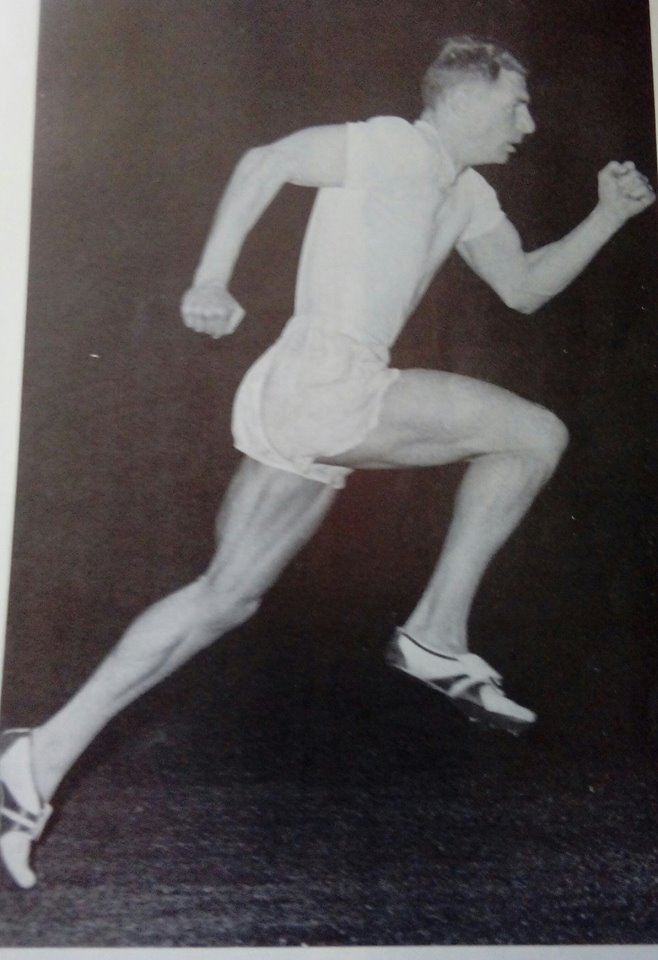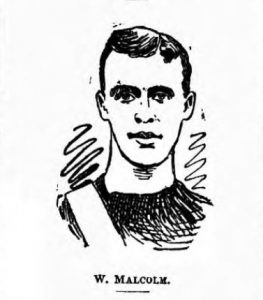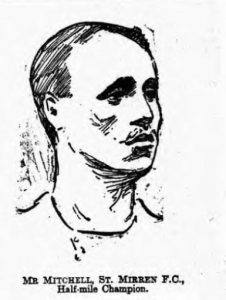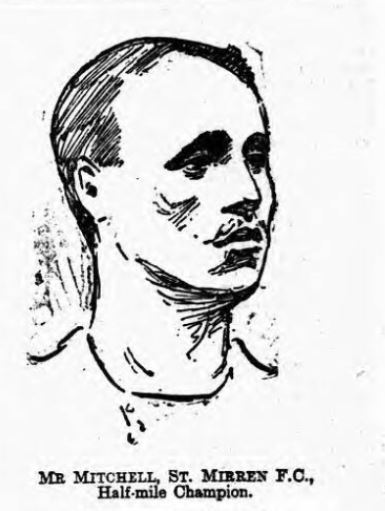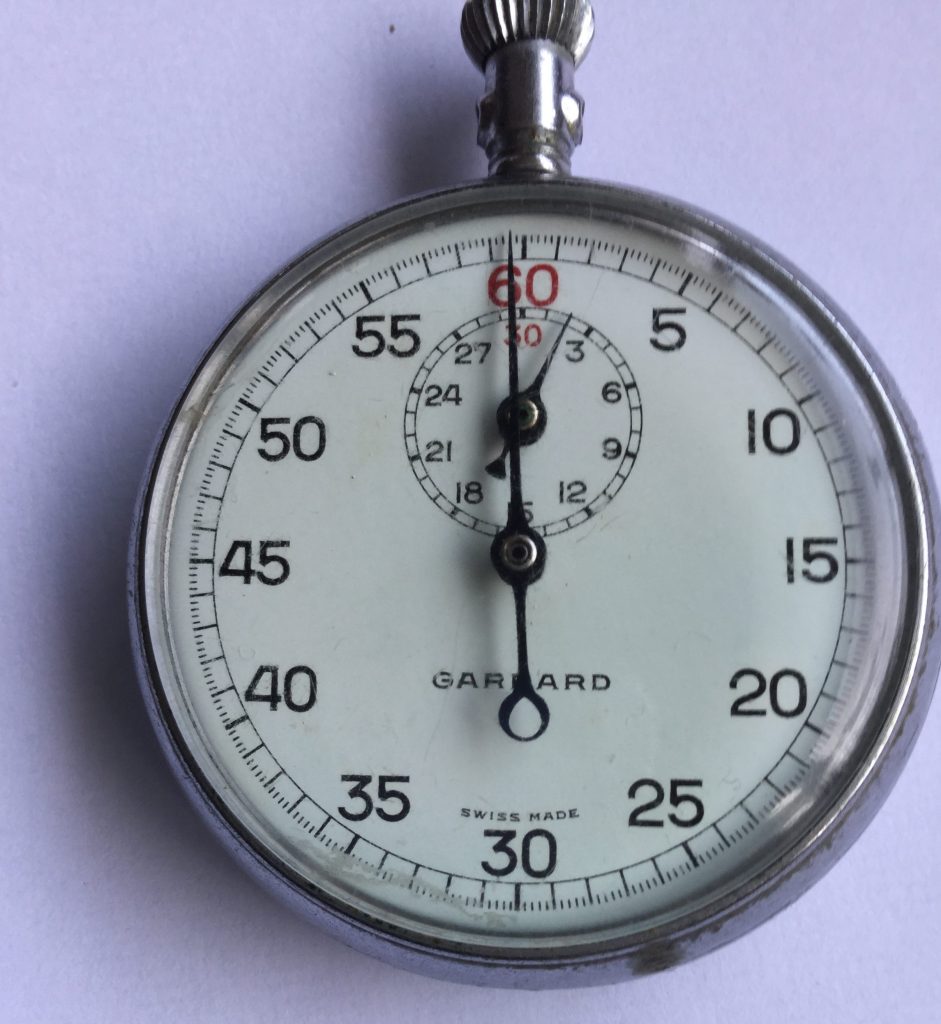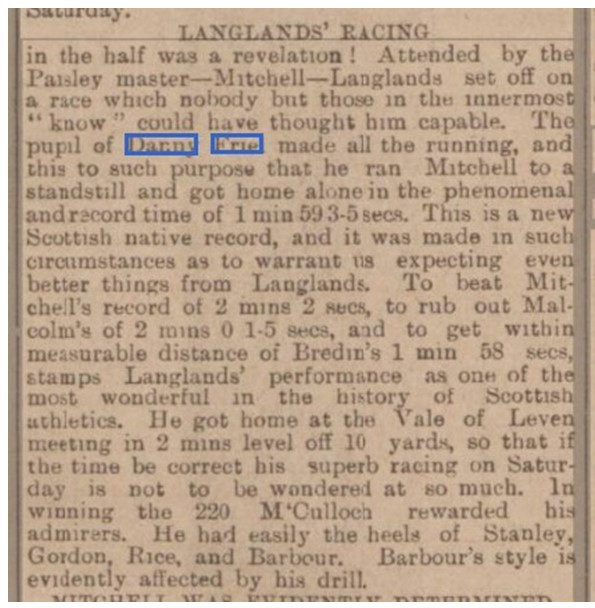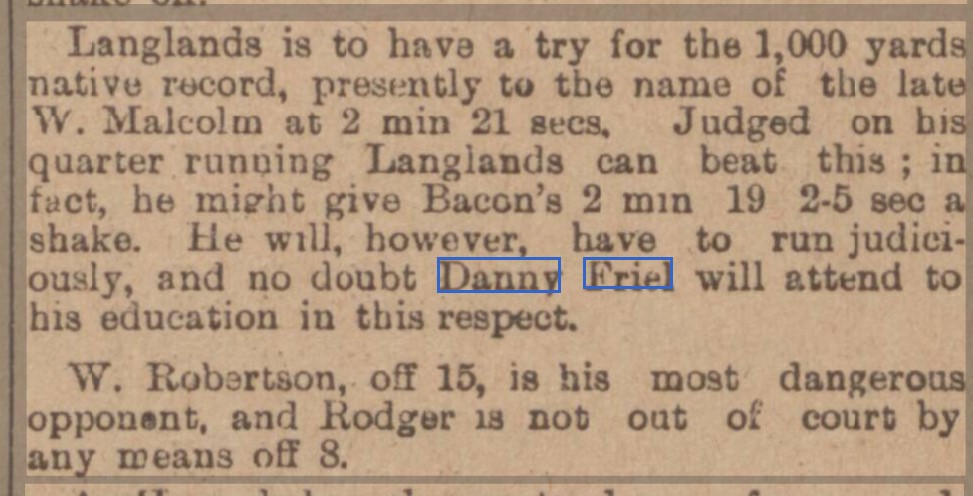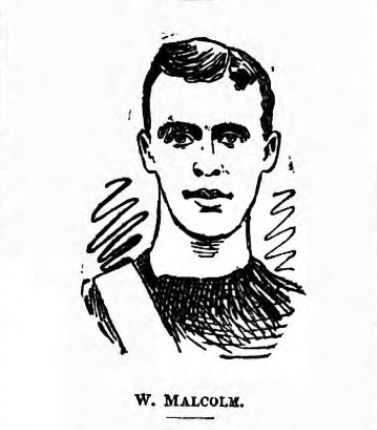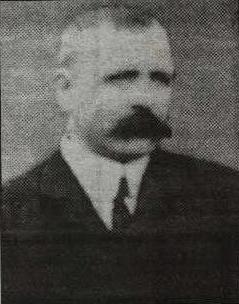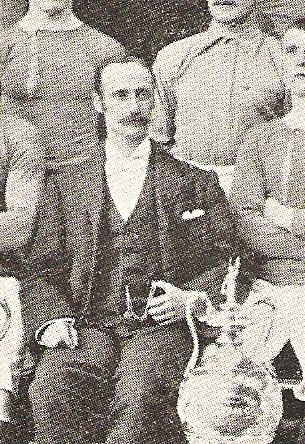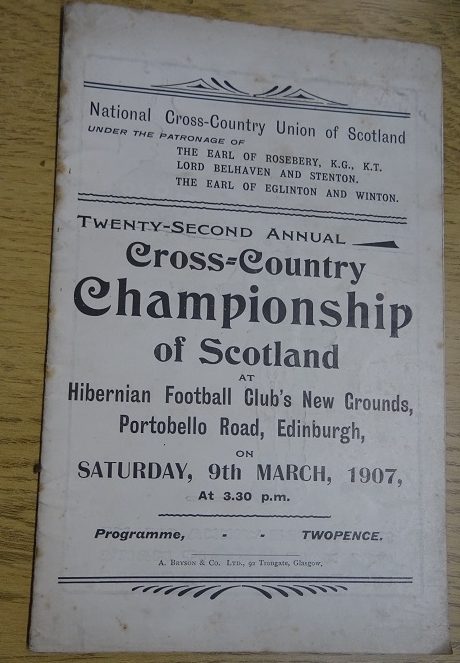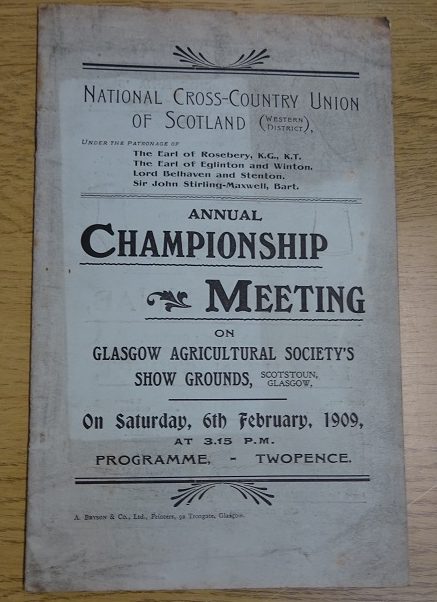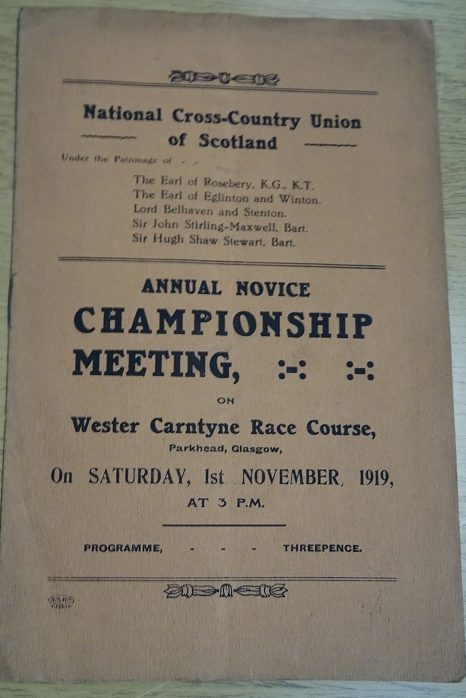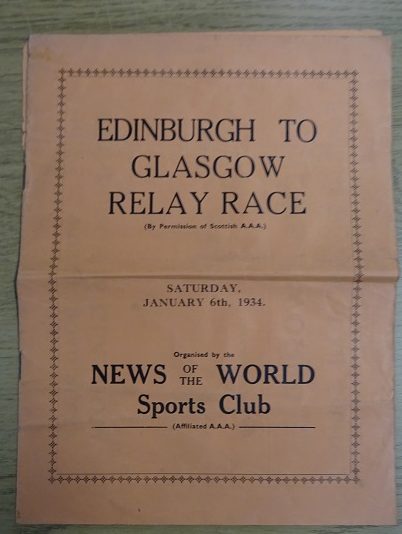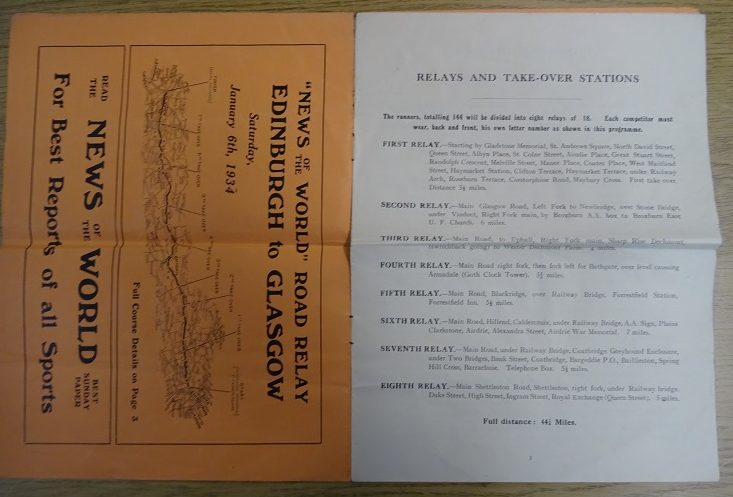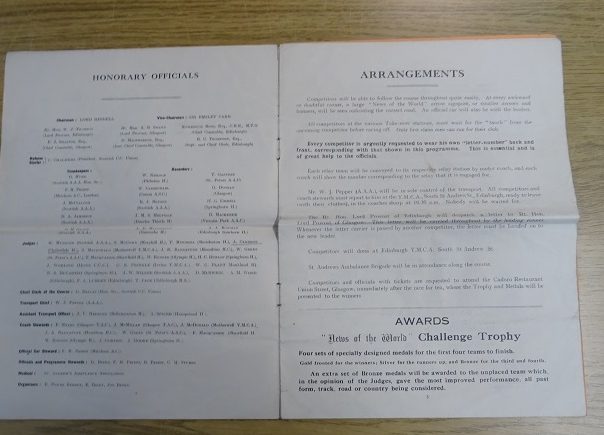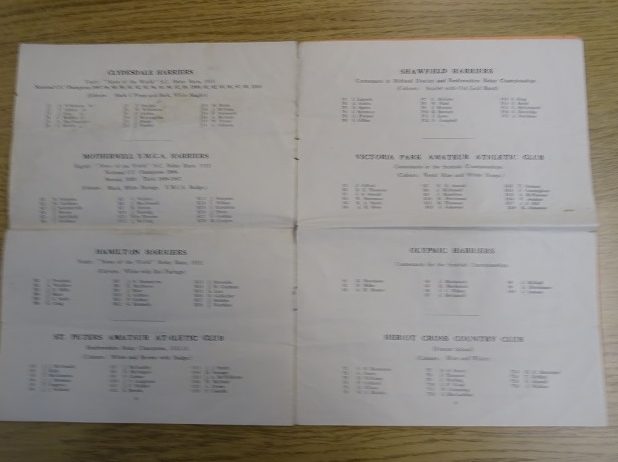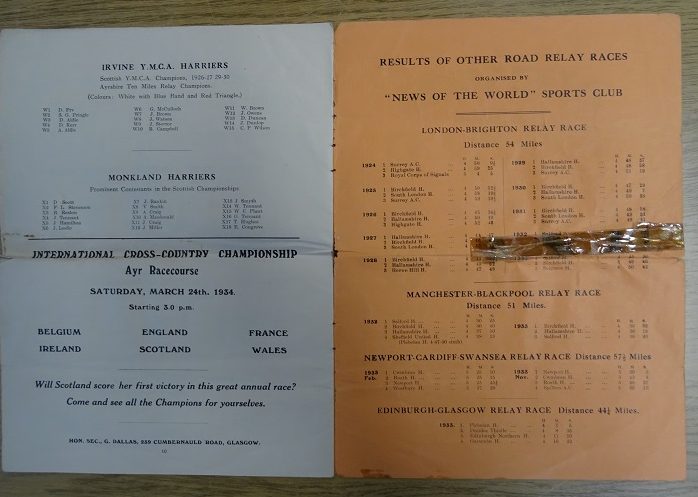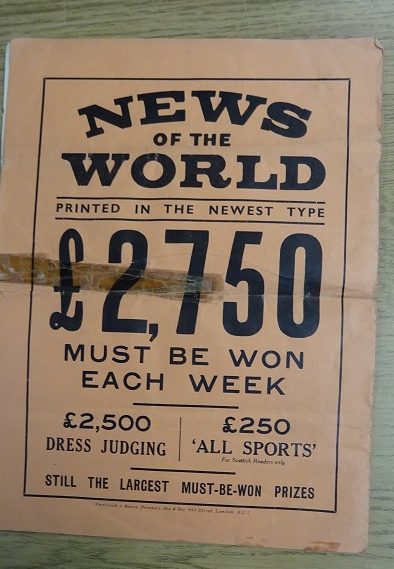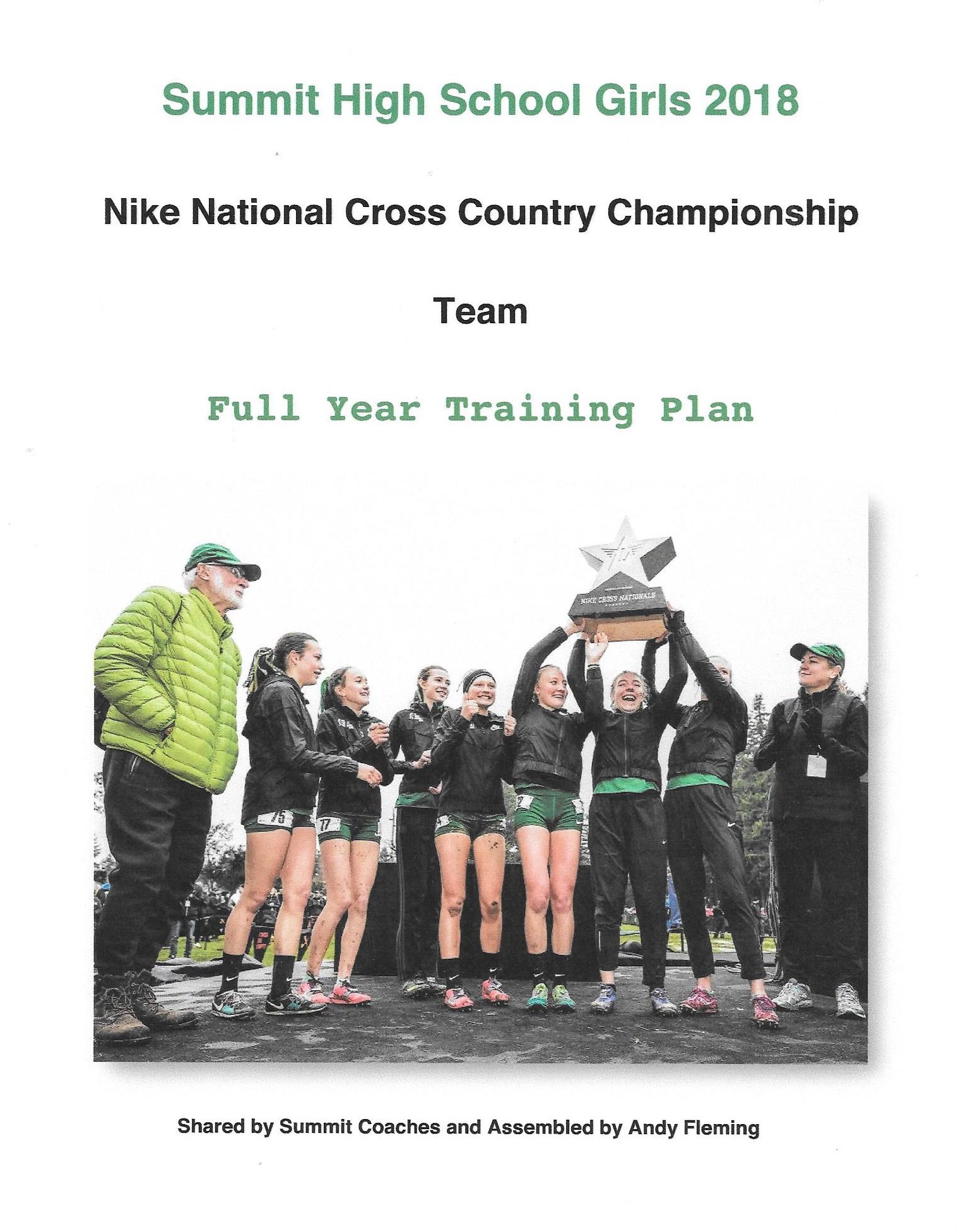
Introduction
The Summit high school girls’ varsity cross country running team as a group early in the season approached coaches Carol and Jim McLatchie and said that every one of the girls is committed to staying and training together in Bend over Thanksgiving break to prepare for Nike Cross Nationals (NXN). This was the first time every runner committed to train together over Thanksgiving break and it showed a true commitment to the team and the belief that this could be a special season. A successful cross country season is made up of consistent hard work and key milestones along the way. Committing to train with the team 100% was certainly one. An additional significant event that occurred late in the season was when coach Jim McLatchie suffered a stroke which necessitated lifesaving treatment in the ambulance and the emergency room at the hospital, multiple days in the critical care center, and additional days and nights in the hospital rehab center. Jim had a lot of visitors and while he couldn’t remember
every person who came to see him and sit by his side, every day he told coach Carol McLatchie, his wife, the varsity team’s workout for that day. Jim was recovering quickly after some days in the rehab center and he talked his way into being let out of the hospital for part of the day to attend the district cross country meet at Central Oregon Community College. Jim’s commitment to the team is such that being in the hospital wasn’t going to keep him from thinking up workouts and attending every race possible to help the team; even if it meant he had to agree to having a person shadow him the whole time to make sure he didn’t fall and had to return to the hospital right after the race. The Summit girls won the race, qualified for the State meet, celebrated with hugs all around, and then prepared for the next training day. There are certainly key moments that stand out during a season that make it a memorable season. There are also the daily workouts, races, and recovery days and while these days may not get the spotlight they build on the day before and are what make a great team. A successful season is created by showing up every day, putting in the hard work, and enjoying the process. And, when it does happen, it certainly helps to really come together as a team and commit to achieving something that is impossible to achieve as individuals.
On Saturday, December 1st 2018 our Summit high school’s girls’ cross country running team, running as the team name Central Oregon, won Nike Cross Nationals (NXN) in Portland Oregon. Summit is the first team west of Minnesota and only the second team outside of New York to win NXN. Summit’s (OR) team’s score was 120 (runners 1-5), North Naperville (IL), the second place team’s score was 186, and Wayzata (MN), the third placed team’s score was 207. Every team that raced at NXN put in a lot of hard work, dedication, and training to make it to NXN. Summit’s goal is to put in the hard work that will help our team be competitive in every race we enter and it was a great achievement to win a National Championship. Cross country is a team sport and our coaching staff and runners have benefited immensely from coaches across the country and the world who have selflessly shared their training knowledge.
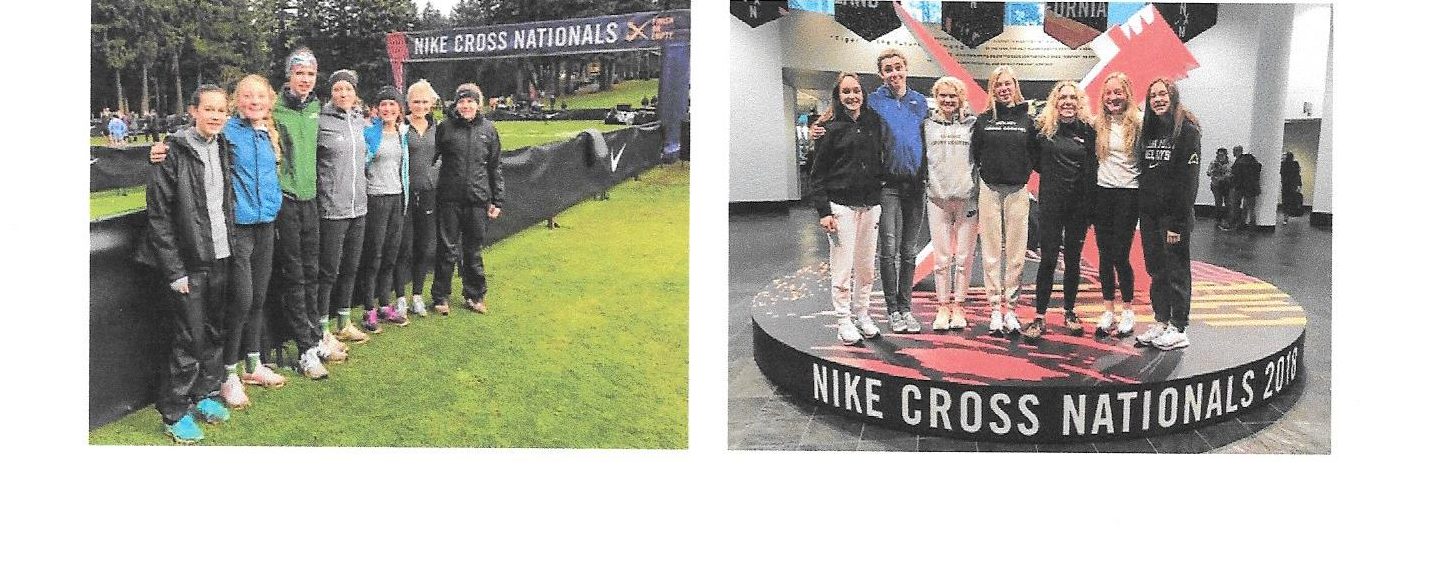
We are sharing our 2018 season training plan and we hope that high school runners and coaches find it interesting and find some things that will work for their teams. Our hope is that coaches continue to share their knowledge to continually improve the sport of cross country that we all love. Please, if you have ideas to share to help improve our team and running community, let us know.
Before we get into the meat and potatoes of our 2018 training program we want to present a general overview of the coaching support we have, the environment we are fortunate to train in, and additional things we hope you find of interest. Also, many who read this will likely be well versed in how cross country running races are scored. For those who may not know, in a varsity cross country running 5K race each team can enter seven runners and the top five finishers on each team score points for their team. As an example, the first place finisher in the race scores 1 point and the tenth place finisher in the race scores 10 points. The goal is for the team to score the lowest amount of points.
Team
Summit cross country benefits from having over 80 runners on the team and a large number of coaches who help supervise workouts. We have 10 coaches, some split salaries, and the majority volunteer their time. We want to thank our coaches for their dedication to our high school runners, Carol McLatchie (head coach), and assistant coaches Jim McLatchie, Chris Shunk, Damian Olson, Stacey Hager, Dave Sjogren, Brendan Layden, Carrie Carney, J.D. Downing, and Kari Strang. Our high school runners train in one of three training groups. Black group, silver group, and green group. All groups are co-ed and they are based on current running ability. We have a 4K time trial at the beginning of the season to place runners into their appropriate ability running groups. Our fastest girls and boys train in the black group and this year the black group was made up of 32 runners. Some runners moved down groups and some up groups during the year based on their race times. Many parents are very involved in supporting our team and a great way they help with team bonding is by hosting team dinners.
Environment
We are fortunate to live in train in Bend, Oregon and many of our parents are athletes so our runners have grown up in the outdoors and being active. Bend is at 3,623 feet elevation and we usually have sunny days and moderate temperatures.
Month High / Low (°F) Rain
July 82° / 47° 2 days
August 81° / 46° 2 days
September 74° / 39° 1 day
October 62° / 33° 3 days
November 48° / 28° 4 days
We train on the surfaces we race on. We have an 800 meter grass loop at our school; a rectangle around soccer, baseball, and softball fields. Our school is a half mile from dirt running trails. The hills we run on are dirt and we fortified one long hill with crushed stone for level footing. We have a track and we mainly use it for 150 meter pickups at the end of practice, but otherwise it is rare that we train on our track during the cross country season. These past two years we have suffered from smoky summers, smoky days during preseason, and smoky early season practices which has forced us to train indoors due to air quality advisories. We run in the school hallways and lift in the weight room.
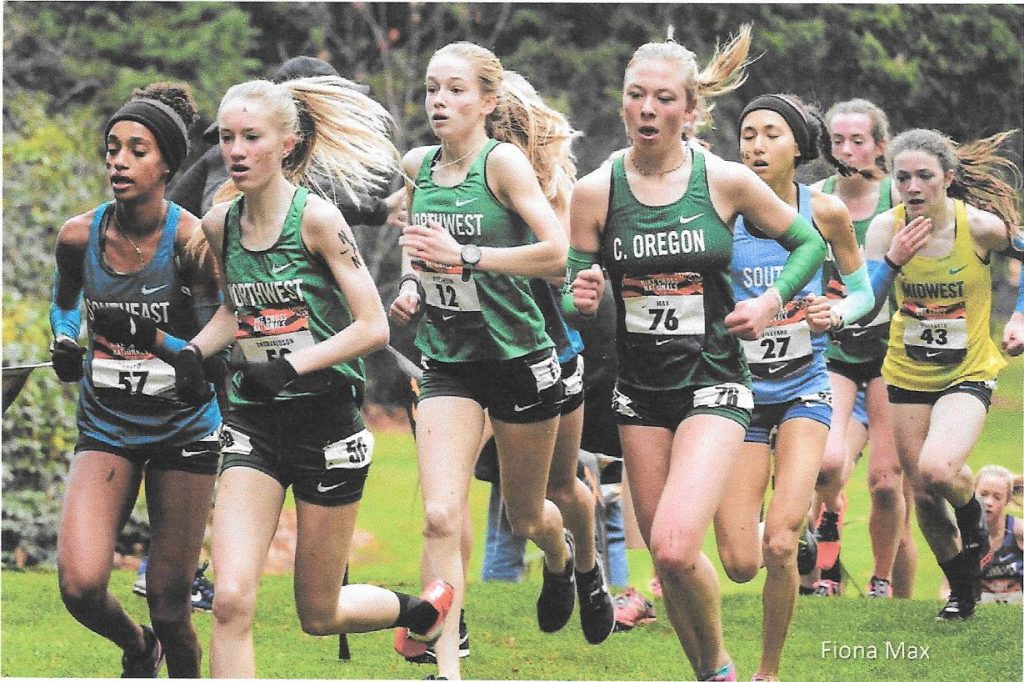
Captains and Team Attendance
Captains are chosen at the beginning of the year by their peers voting for them and coaches also have input. Captains help out in numerous ways. One main way is in taking attendance every day at practice by having clip boards and each individual runner is responsible for checking in with them and being marked present. If a runner misses practice they have to contact head coach Carol McLatchie and let her know the reason. Committing to training and being accountable are keys to success.
Training During the “Off-Season”
We collect the email addresses for every runner on the team and they are sent a monthly calendar with the dates and details of practices and races. Calendars are also posted on the team website, www.summitcrosscountry.com. During the winter we have practices on Sundays at Drake Park and while these are open to everyone on the team, the majority of the runners who show up are varsity runners. We do have runners from other local high school attend these training sessions. We also have a winter track program were a number of our runners will run, lift in the weight room, and often attend a couple of indoor track meets. During the spring season the majority of our varsity runners run track and train for the 800, 1500 and/or 3,000. During the summer we hold captain practices and we meet three days a week to train. Coaches and parents are in attendance as their summer schedule allows.
Moving from 5A to 6A this year Moving from 5A to 6A our team did pretty much the same workouts, but we made the workouts tougher. This year we increased our captain’s practices in the summer from two days per week to three days per week.
Annual Team Camp: We hold an early season team camp at Scout Lake near Sisters, OR for three days of running and team bonding. We have team easy runs, a competition running up to the top of Cache mountain where the top 10 girls and boys receive a prize, and the final day we a three person team relay that includes running and swimming. We also have a parent cookout night where all parents are invited to grill, eat, and spend quality time with each other and our team.
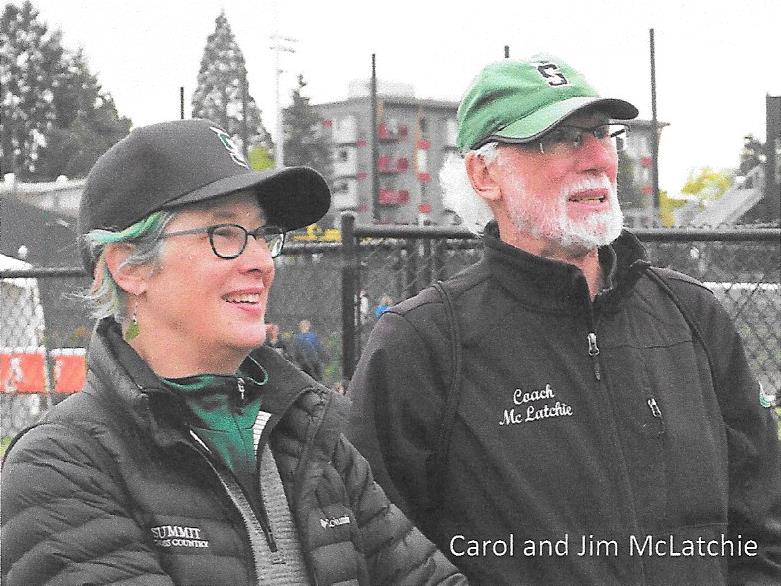
4K Time Trial to Choose Training Groups: We hold a 4K team time trial at Drake Park and based on runner’s times they are placed into the black, silver, or green running groups. Runners of similar ability train together to get the most out of their training. Runners are often motivated to improve and we allow them to run themselves into different groups during the XC season. We invite parents and former runners to cheer on the current team and enjoy each other’s company.
In Season Workouts: Every workout should have a purpose and the coach should be able to articulate the purpose for every workout.
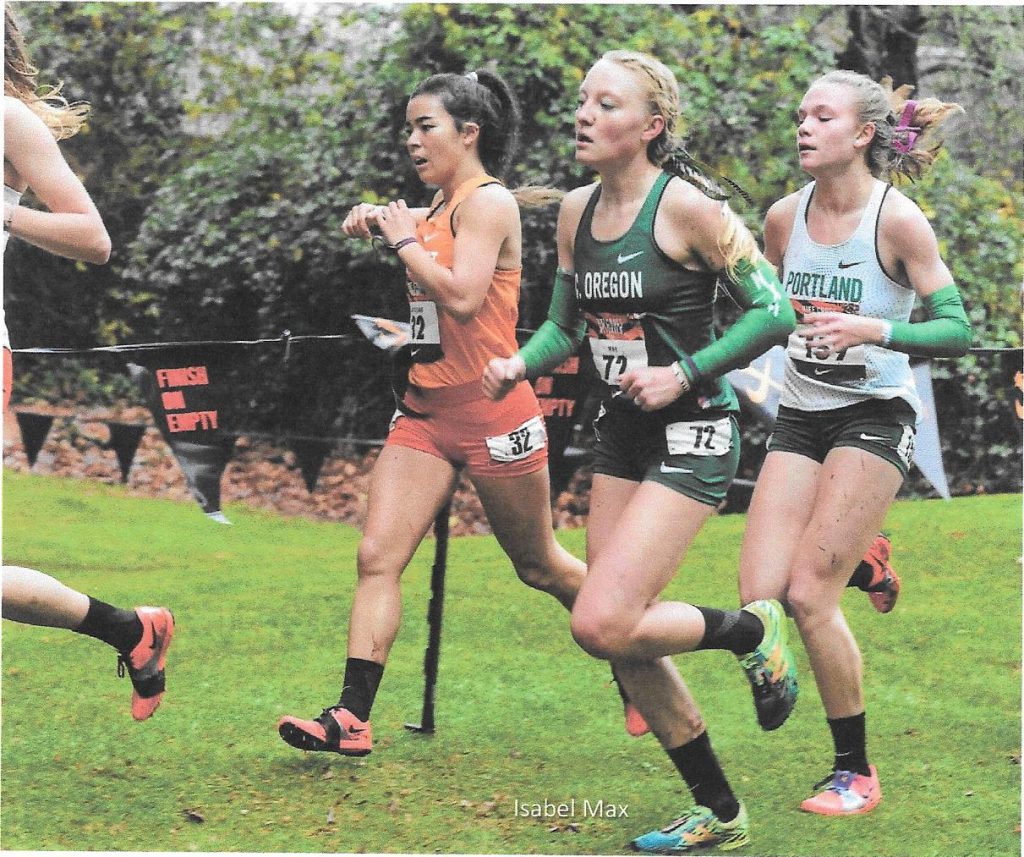
Weekly Workouts (General)
Monday – Hills workout. Strides.
Tuesday – Easy run (45-60 mins.) Strides. Core workout. Weights.
Wednesday – Grass workout (800 meter loop). Strides.
Thursday – Easy run (45-60 mins.) Strides. Core workout.
Friday – Easy run (30-40 mins.) Strides.
Saturday – Race
Sunday – Easy run (45-60 mins.)
Additional Morning Shakeout Run
For some top and motivated runners they will run 30 mins shake out in the morning
during the week. This year we had 2-3 runners on the girls varsity team doing these easy early
morning runs.
Workouts are Modified as Needed
As a principal, workouts are not set in stone, they can change due to weather and race schedule. Also if a runner is sick or tired their workout will be either cancelled or adjusted as needed. We have no problem telling a runner to cut the workout short if they can’t sustain their target pace, if they become injured, or another significant reason.
Every Practice
Every practice Monday through Friday starts with a warm up run (800 meters), drills (see list for drills), and after the daily workout has been completed, finishes with strides which are 4 x 150 meters where each runner progresses progress up to race pace or faster. The 150s at the end of every practice are very important because it trains our runners to know that when they are tired after a workout, and at the end of the race, they can still run very fast and we let them know in a race they should be passing people or not getting passed.
Daily Team Warm Up and Drills
800 meters easy warm-up run
Forward Skip – 50 yards
Backwards Skip – 50 yards
Side Shuffle with arm swings – 50 yards
Backwards run – 50 yards
Knee Pulls – 6
Quad Pulls – 6
Toe Touch – 6
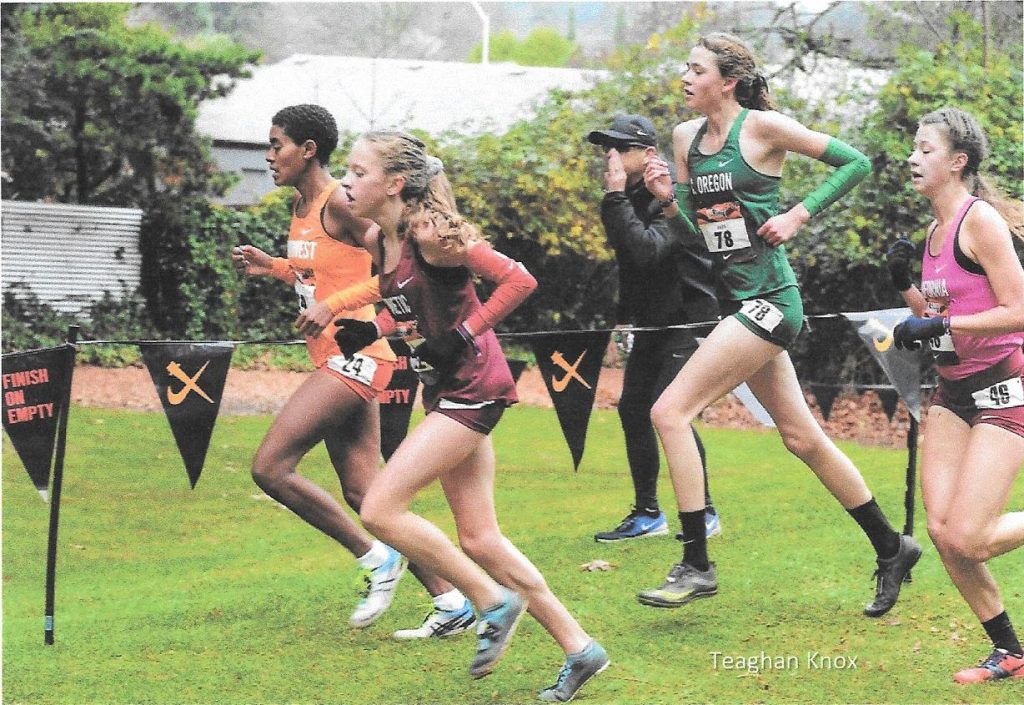
Side Lunges – 5 yards
Regular Lunges – 10 yards
A-Skips – 4 X 20 yards
B-Skips – 2 X 20 yards
“Old School B-Skips” – 2 X 20 yards – good for fast days: provides good range of motion
to warm-up hamstrings
High Heels – 2 X 10 meters
Tip and Gos – 4 X 100 meters (catch breath between sets)
On an Easy Run Day
On an easy run day we will do a plyometric session in addition to the warm up.
Pogos
Tuck Jumps or Box Jumps
Regular Bounding Progression
Speed Bound
Core
Tippy Birds
Plank Rolls
Windshield Wipers
Suitcases
Leg Throws
Balance Toss w/ Med Ball
Push Ups
Weights
We meet each runner where they currently are in their ability to lift weights and not every runner will perform the same weight lifting routine. We have coaches teach lifting techniques and we have coaches in the weight room to monitor for correct form.
Here is the list of the main lifts we do. Sometimes we’ll throw in other things to change it up, but not often. The lifts are in the order we do them, but we do different combinations depending on the time of year. Warm up is usually a good morning/front squat/press/deadlift complex with a light bar or PVC pipe. On more dynamic days we’ll do box jumps before our power cleans or deadlifts.
Lifts:
Deadlift
Power Clean
Hang Clean
Push Press
Split Jerk
Half Squats
Step Downs
Step Ups
Overhead Lunges
Dumbbell Lunges
Stranding Military Press
Shoulder Swings
Hill Workouts (Monday)
For hill workouts, we ask our co-ed runners to run at 90-95% effort. We train on two hills that are about a .5 mile from our school and our team can run to these hills. One hill we run is 500 meters to the top and we have it marked off in 100 meter segments. We instill in our runners that we run past the top, not just run to the top. The second hill is Overturf Butte, a loop that is, depending whether we are running clockwise or counterclockwise, 365 meters uphill and 425 meters downhill, or 425 meters uphill and 365 meters downhill. In a workout we will mix up the direction; for example 6 clockwise and then 6 counterclockwise
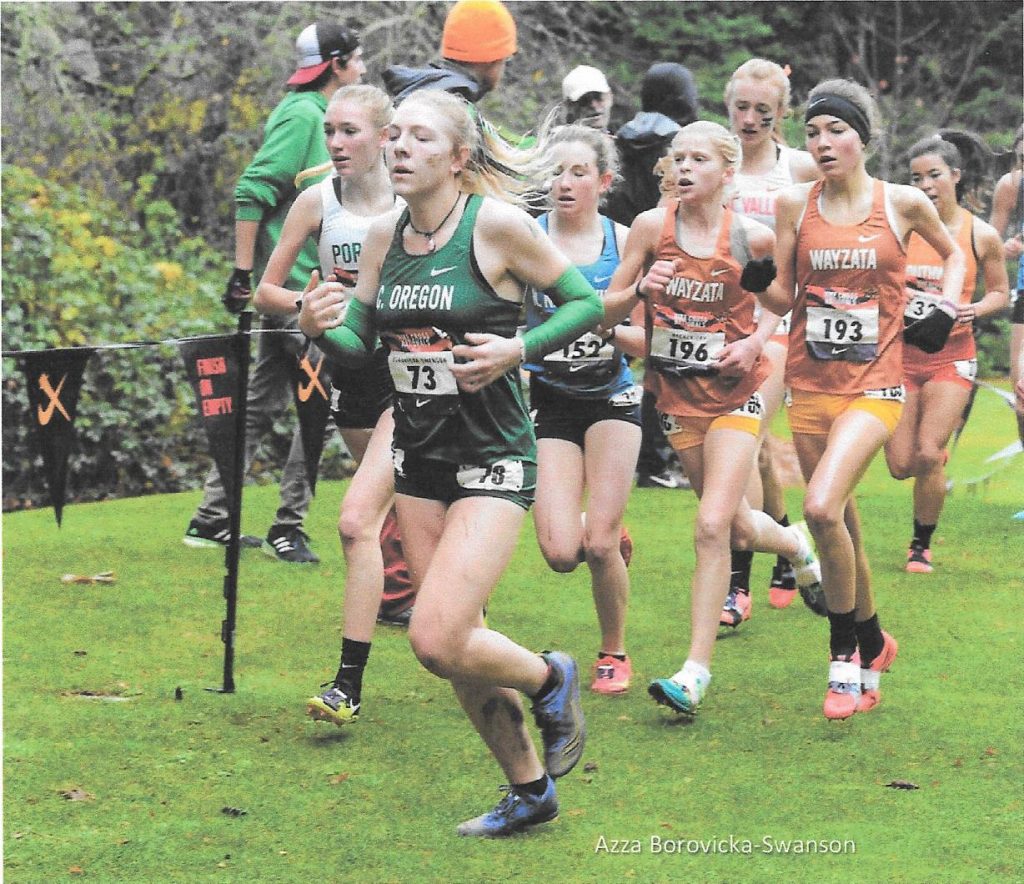
Easy Runs (Tuesday, Thursday, Friday, Sunday)
Easy runs are 1.5 – 2 mins. slower than race pace. For example, if race pace is 6 min. miles, then an easy run is at 7.5 – 8 min. mile pace. We will have girls run with boys if their recovery run speed is similar. We don’t have our runners do tempo runs because we believe easy days are very important to recover from hard days and we believe that it is very difficult to get high school runners to do tempo runs in groups that are specific to their individual speed.
We try and have co-ed runners of similar abilities run together on their easy runs, but we know that some runners will choose to run in groups that are above their easy pace and they are in essence doing a long tempo run or a hard run which may compromise their training and ability to fully recover from hard training days. This can be a recipe for injury or burnout and one that we try to avoid. Easy should be easy, recover days are ways to consolidate all the hard training that was done, and easy days are when the body repairs itself and grows stronger.
We do get questions asking if our team does tempo runs and our grass workouts are the closest we get to tempo runs and probably some runners are doing tempo on “easy days” because they are running with a group of faster runners and they don’t know how to run easy or think it is helpful to have easy runs. This will wear runners out and it will show up in their practice and race performance.
Grass Workouts (Wednesday)
At the beginning of every grass day workout we put runners in co-ed groups based on similar pace and depending on the workout tell them to run at either 80% or 90% of their race pace. The total distance of the grass loop is 800 meters. Specifically, the length of the grass we run on is long, there is a 10 meter hill, that leads to a 200 meter slightly downhill asphalt section, and the remaining grass section of 400 to 600 meters are a mix of wet to swampy grass due to the sprinkler system and a drainage issues on the outer grass fields.
Choosing the Team for Race Day
Coaches meet in the days before a meet to decide who will run varsity and submit the names of the seven girls who will race varsity. The team mostly picks itself by their race results from their prior race. We sometimes have runners who run a great J.V. race and race themselves onto the varsity starting seven. But, coaches have the discretion to decide the final varsity team for the upcoming race because a number of factors can be at play in deciding who will run varsity this week; including if a runner was sick, injured, had a bad race, or any current circumstance that factors into who should race varsity in the upcoming race. This is also a good time for the coaches to check in with each other about how all the training groups are going and how they are doing personally as well. We try and look out for our runners and our coaches wellbeing.
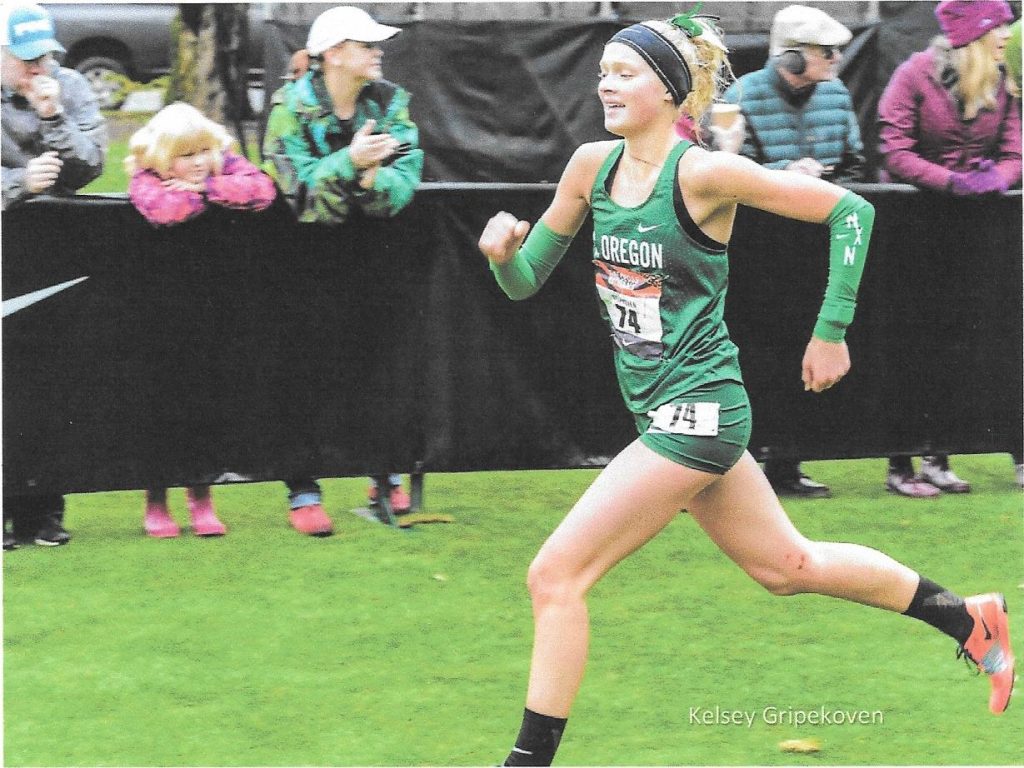
Race Day
On race day coach Jim McLatchie will walk the course and tell our team where all the holes, wet spots, and dangerous corners are located. If Jim has any concerns about holes or dangerous parts on the course he shares this information with the race organizer to try and make the course safe for all runners. He then meets with the varsity runners tells them the race strategy for the day. An hour before the race the varsity girls will go for a group warm up run. Fifteen minutes before the race the team will go to the starting box and start their drills and strides. Coaches will be at the start with baskets to take warmups and other clothing back to the tent. If it’s a cold day coach Carol McLatchie will have olive oil on hand to give to the girls so they can rub it on their exposed skin to keep themselves warm at the start of the race. As the race progresses the skin heats up and the layer of olive oil “sweats” off. Coaches are strategically placed around different parts of the course to yell out split times, encouragement, and sometimes that all important “go now” (if you can) directive. At the end of the race the girls return to the team tent to put on warm clothes, hear some encouraging words from teammates, coaches, and parents, and then they are off together for either the awards ceremony and/or their team cooldown. Finally, it’s time to pack up the tents and gear, get on the bus, and because we usually race out of town, get food at a grocery store before the bus ride back over the mountains.
Races in 2018 and Race Strategies
Our varsity girls team raced 10 races this season. We had 7 races on our calendar including districts, then our 8th race was State, 9th race was Nike Cross Regionals (NXR), and 10th race was Nike Cross Nationals (NXN). All season long the whole team really cheered each other on. We trained for our early season and mid-season races by training at today’s race pace; the current pace our runners were racing at. Then we cranked up the training in late season for State, NXR, and NXN training at goal pace, which we call “winning pace” the pace coaches think each individual girl will be capable of racing at.
We trained through State and NXR, meaning that we didn’t taper during this time. The evening before the State meet, Peter Thompson, a coach for over 50 years, talked with the girlsand boys teams. He reminded them that they had already put in all the hard work in their training and that it was important tonight and tomorrow morning “to keep the lid on the kettle”, to control and contain their emotional energy – until it was time, at the gun, “to let the lid off the kettle and put all the hard work and ’emotional steam’ to work during the race”. Following State, the athletes carried this thought into NXR and NXN. From NXR to NXN we tapered one week before NXN where we eliminated hills, eliminated weights, and tapered overall running. An important point to highlight is that to go to NXN and race our best we needed our team to commit to staying in Bend and training with the whole team over Thanksgiving break. That conversation started well before State. Runners and parents recognized this great opportunity to be competitive at State, NXR, and NXN. Our whole team trained together for the first time over Thanksgiving and it ultimately showed in our NXN
race results.
Our NXN race strategy was to go out quick, but not too quick. To believe that we can win this. We put in the hard work and on the start line it was, again, time, “to take the lid off the kettle”. And, at the 4K mark it was the time to go for it all, in the final 1K.
Annual Soccer Game
And importantly, we have a yearly end of season tradition where we play a soccer game on the turf field because Jim McLatchie is a huge soccer fan, it’s Scotland vs. USA, and it’s awesome. Sharing with our Running Community We have had a number of cross country great seasons, this season was very special, and we are already putting in the work daily for the upcoming track and cross country seasons. We have fun because we see the progress and improvement in every runner who works hard. It is fulfilling as a runner to improve and as a coach to see the improvement. Our hope is that sharing our workouts will provide you with some ideas to incorporate into your training and racing plans.
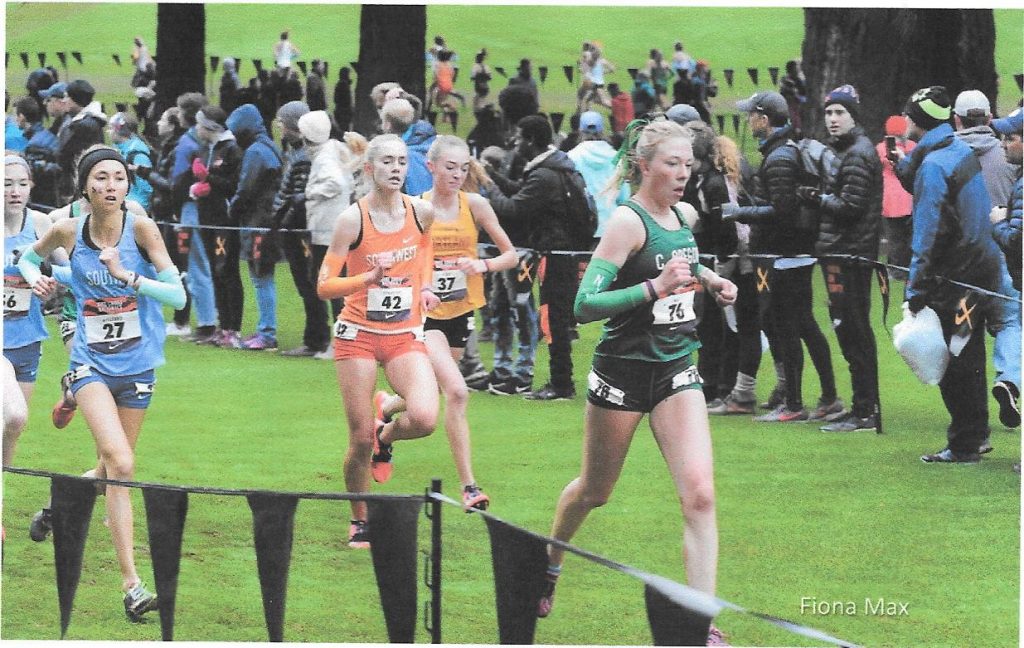
Our hope is that you will also share your training and racing plans with our team and additional teams so that high school cross country runners can continue to develop and improve. Here is a calendar listing every workout for our 2018 season.
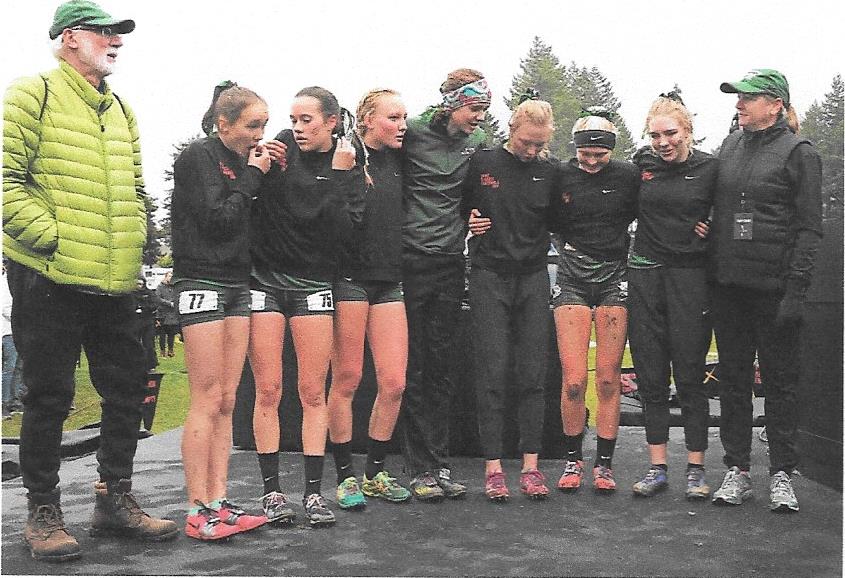
From left – Jim McLatchie, Jasper Fievet (SO), Stella Skovborg (JR), Isabel Max (JR), Teaghan Knox (FR), Fiona Max (JR), Kelsey Gripekoven (JR), Azza Borovicka-Swanson (JR) and Stacey Hager
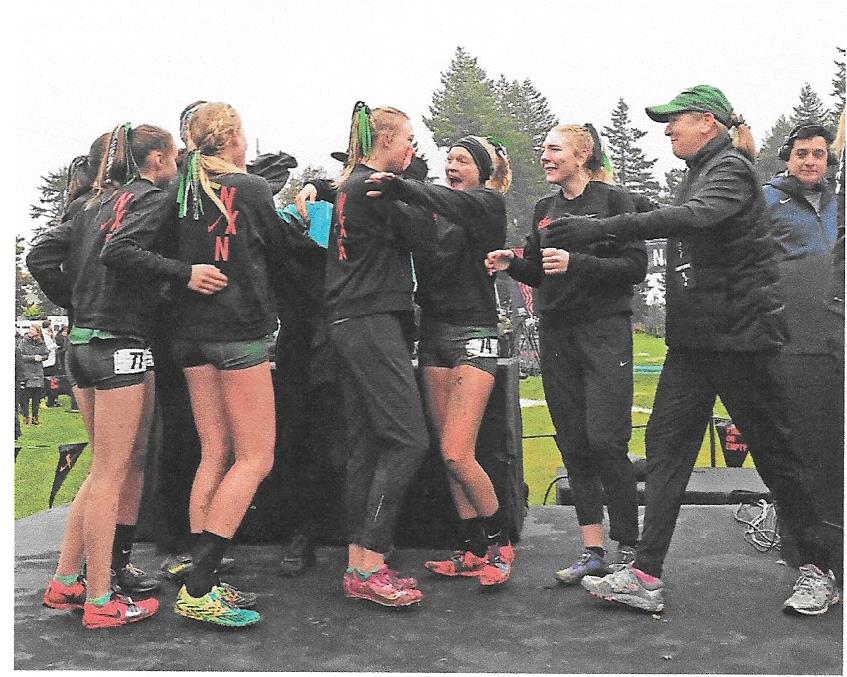
Full Year 2018 Training Schedule, Every Single Workout
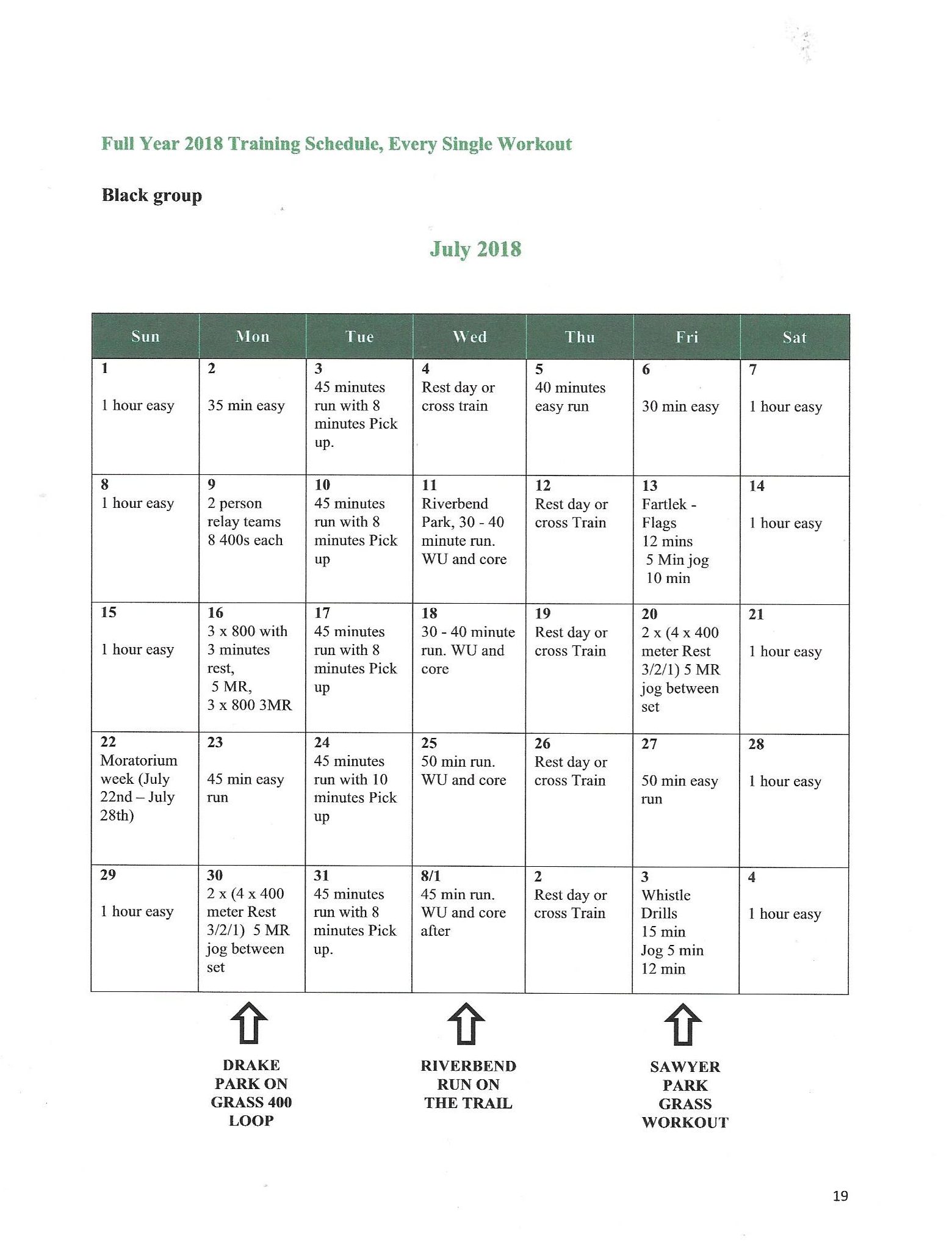
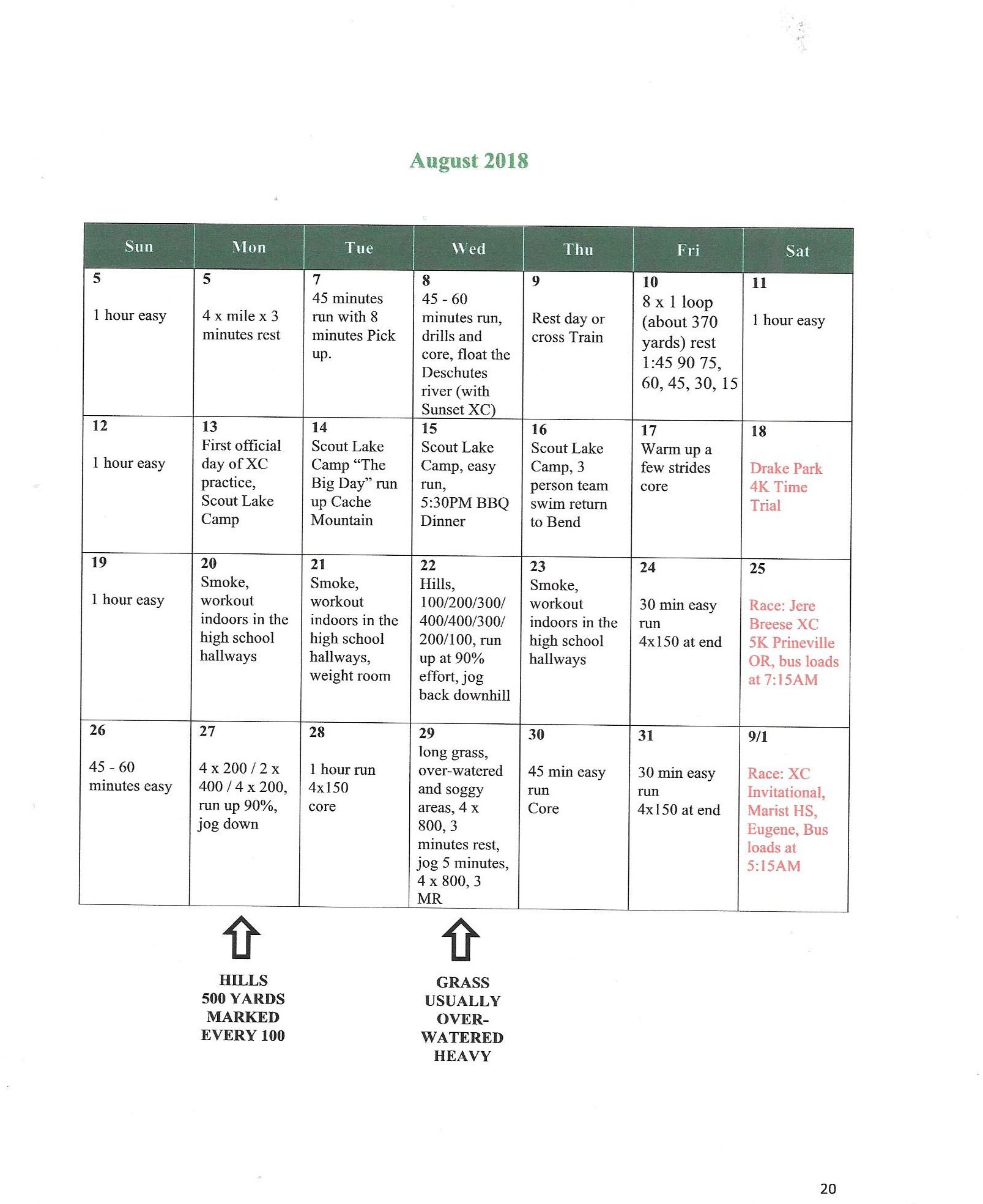
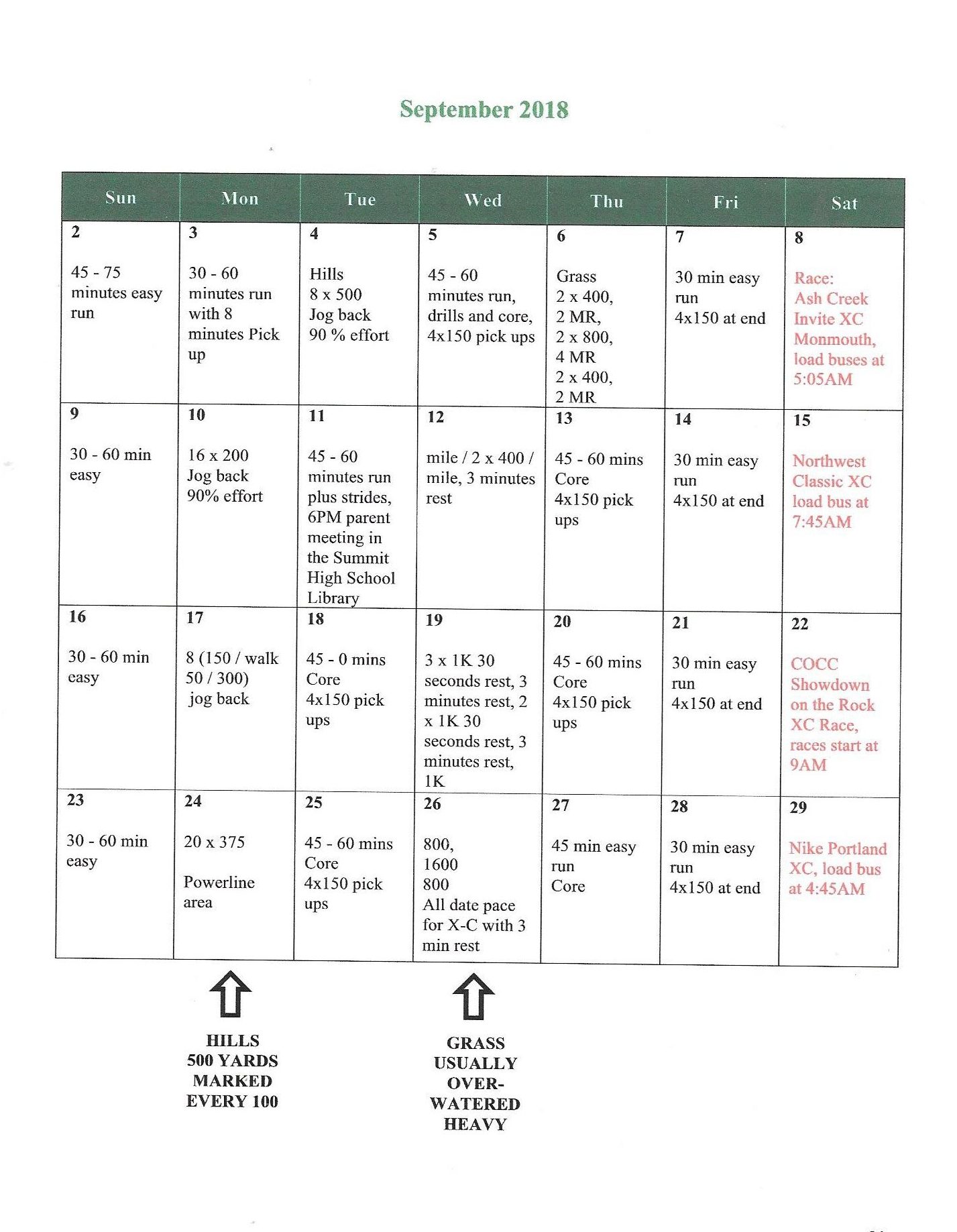
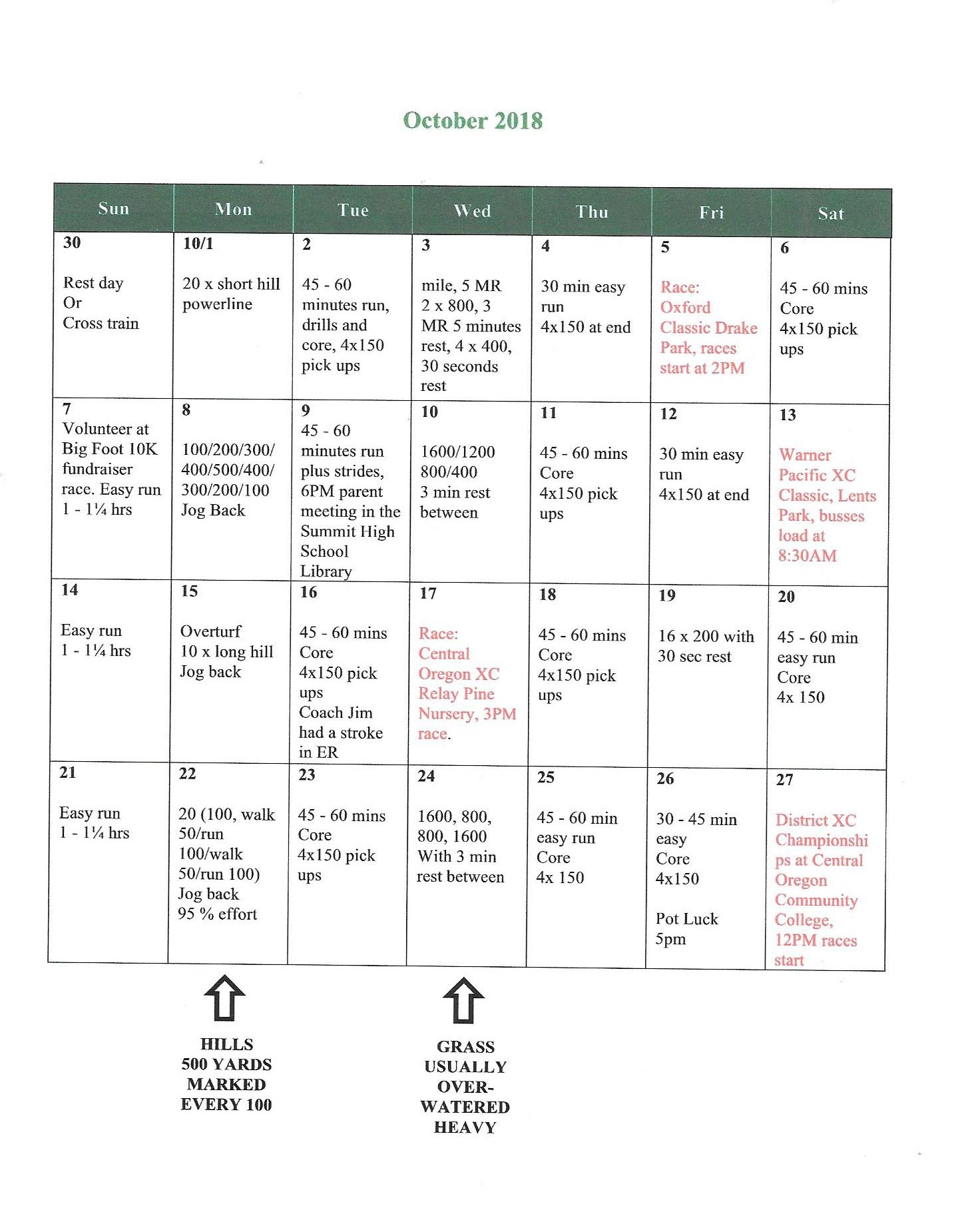
____________________
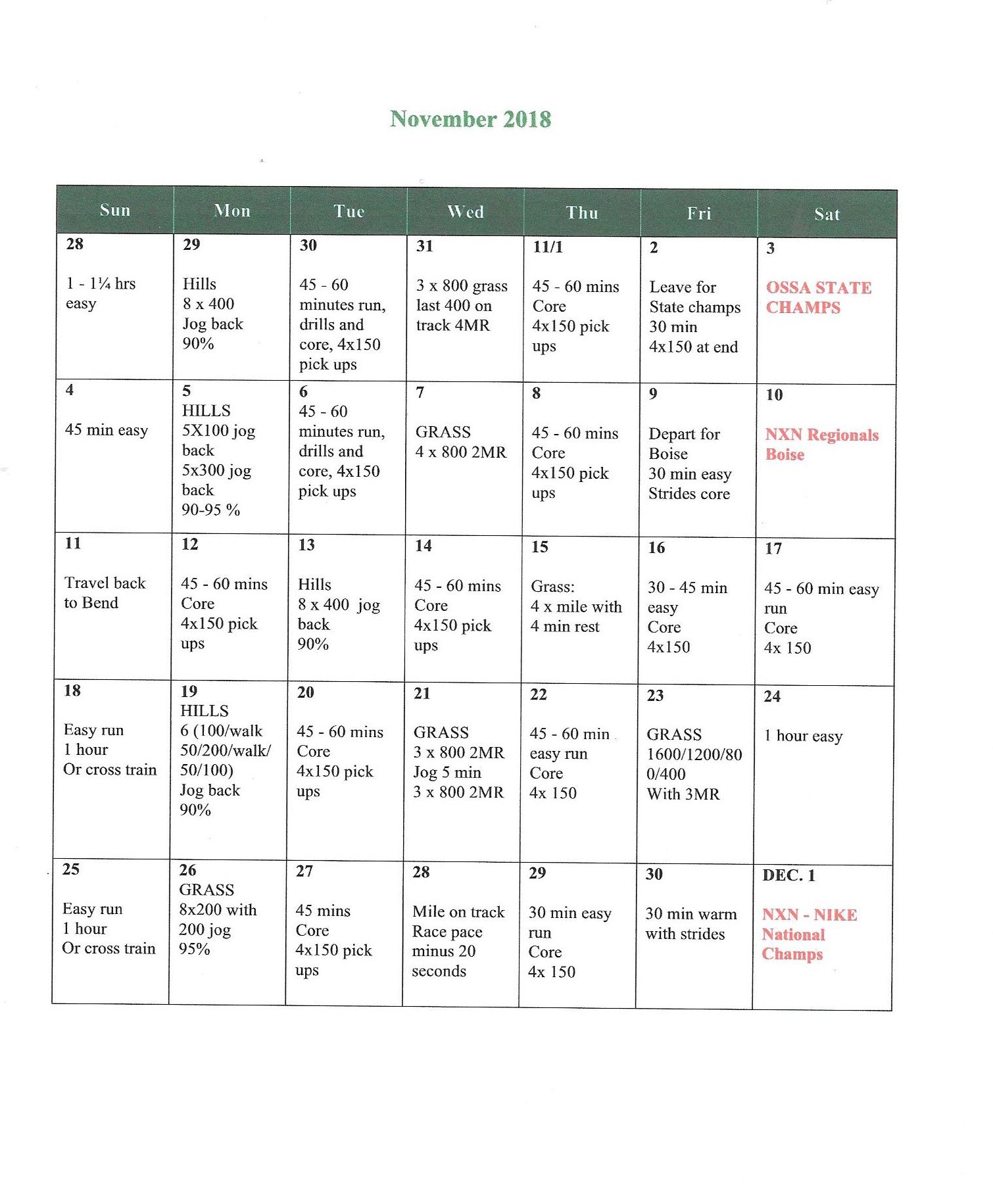
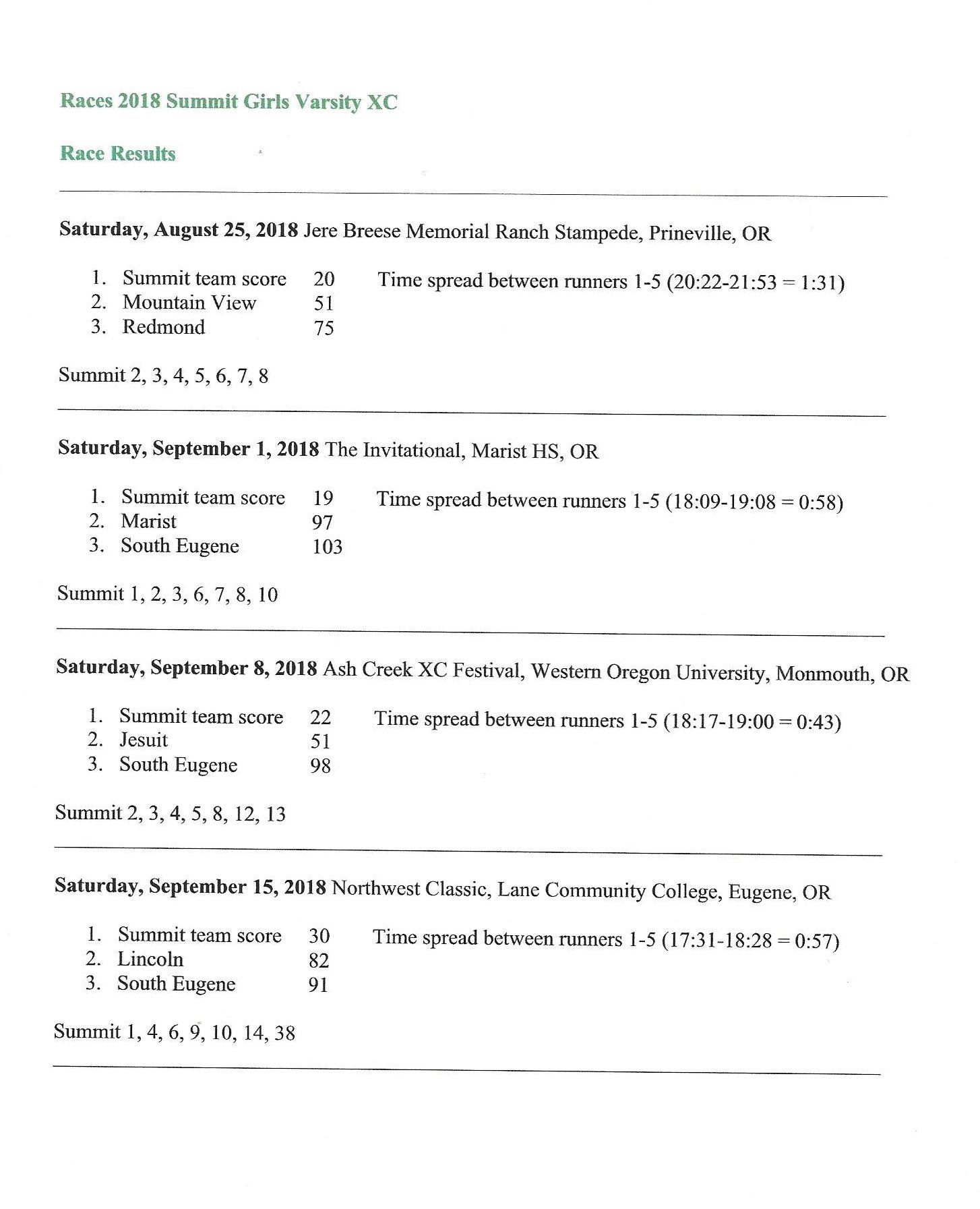
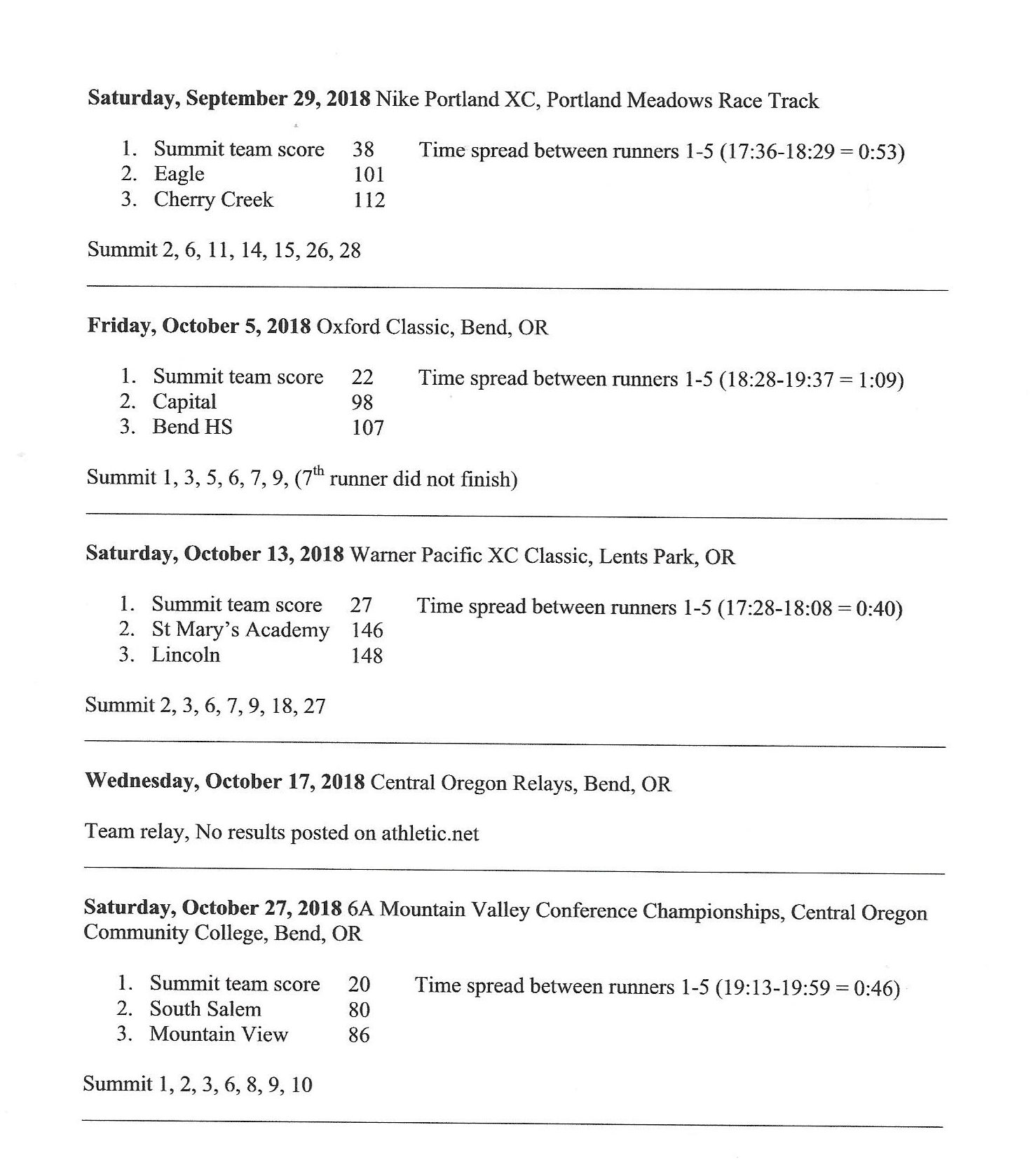
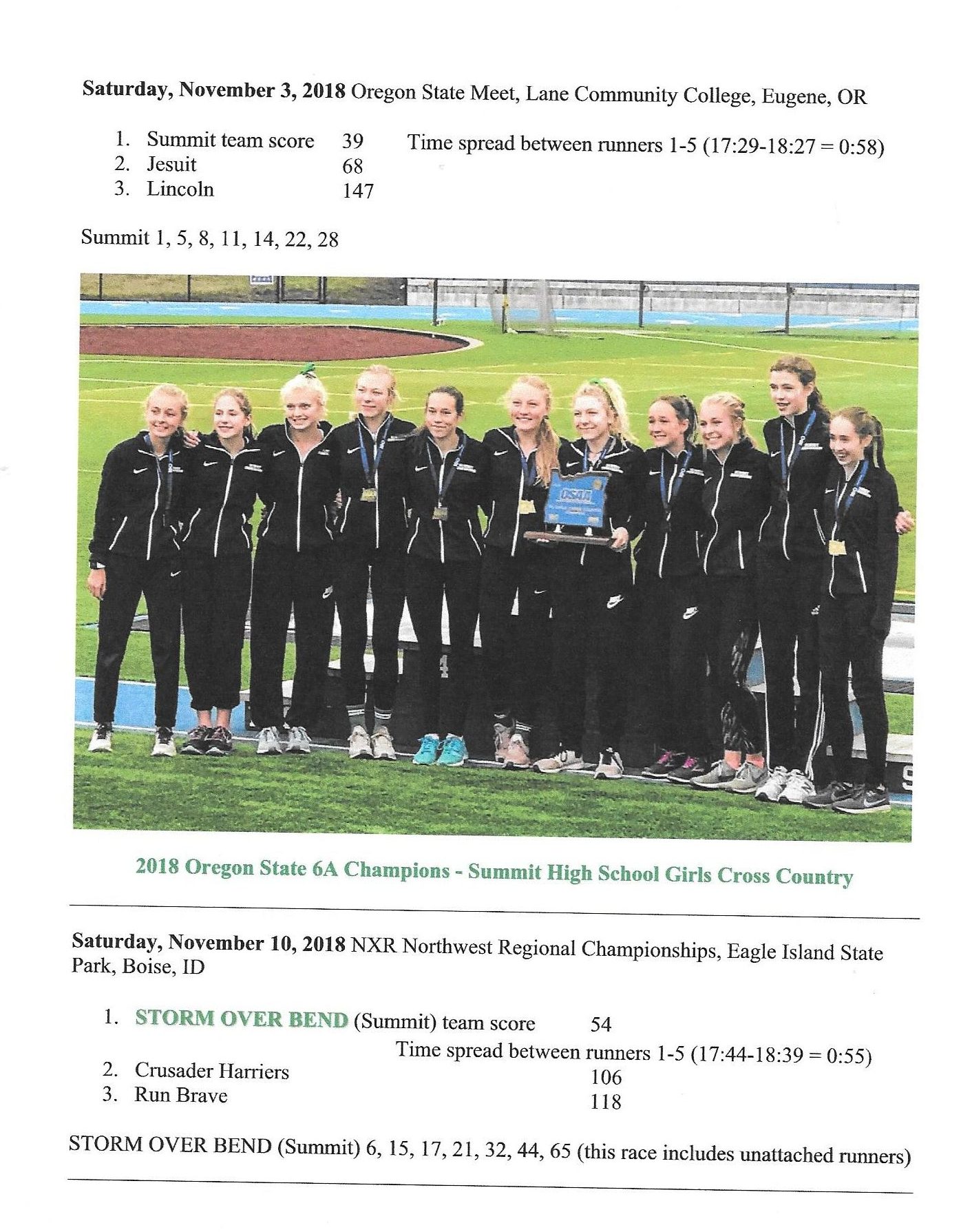
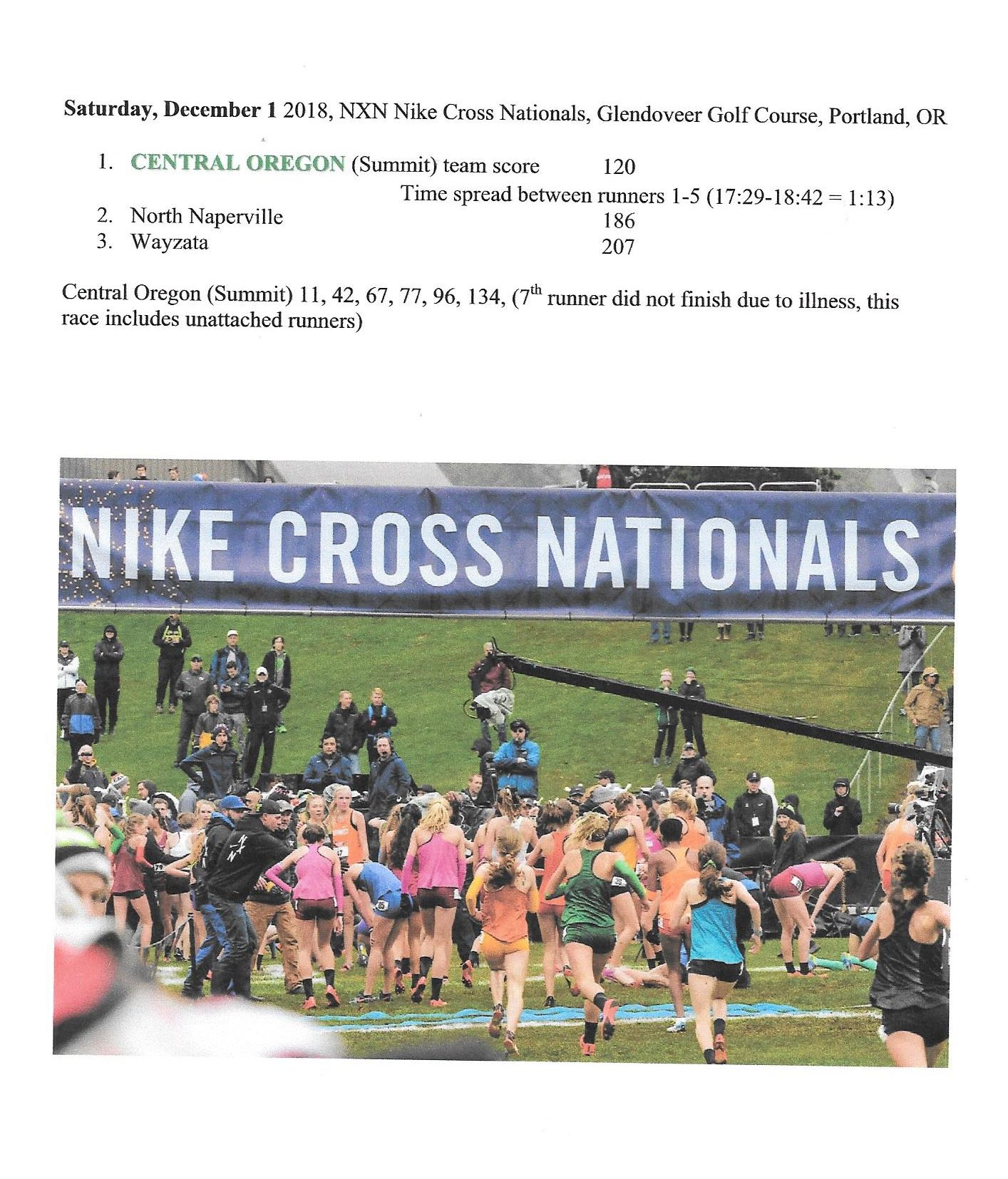
27
Saturday, December 1 2018, NXN Nike Cross Nationals, Glendoveer Golf Course, Portland, OR
1. CENTRAL OREGON (Summit) team score 120
Time spread between runners 1-5 (17:29-18:42 = 1:13)
2. North Naperville 186
3. Wayzata 207
Central Oregon (Summit) 11, 42, 67, 77, 96, 134, (7th runner did not finish due to illness, this
race includes unattached runners)
28
2018 NXN Champions – Central Oregon (Summit High School)
Athletes Coaches
Fiona Max (JR) Carol McLatchie (Head coach)
Teaghan Knox (FR) Jim McLatchie
Kelsey Gripekoven (JR) Dave Sjogren Stacey Hager
Isabel Max (JR) Kari Strang Damian Olson
Azza Borovicka-Swanson (JR) Brendan Layden Carrie Carney
Stella Skovborg (JR) Chris Shunk J.D. Downing
Jasper Fievet (SO)
Head Coach
Carol McLatchie
Carol and Jim McLatchie
2018 USTFCCCA
High School Girls Cross Country
Coach of the Year – Oregon
29
“The key is team and a part of that concept includes the teamwork between
coaches. Jim has been coaching for over 64 years and we have been married for
over 35 years. Prior to that I ran, with Jim as my coach for 5 years. My name is
listed as ‘Head coach’, but Jim and I operate as a team, so the credit should go to
Jim, myself and the rest of our team, including our athletic directors (Gabe
Pagano and now Mike Carpenter), principals (Alice DeWittie now Michael
McDonald), Dave Turnbull (Head track and field coach) and close friends and
parents that are always there for us and the athletes. Summit’s mascot is the
‘Storm’. 2018 was our ‘Perfect Storm’, for our team of coaches and a team of
girls and boys that all came together for one huge goal: to win the Oregon state
XC meet and NXN. Go Storm! I am so proud of you all.”
Carol McLatchie
2018 USTFCCCA National High School Girls Cross Country Coach of the Year
Photos by Stacey Hager, Peter Thompson, Kari Strang and John Swenson
Andy Fleming, April 2019




















